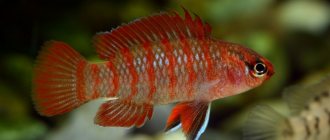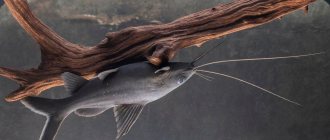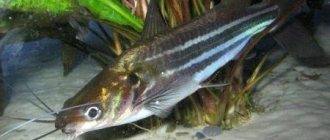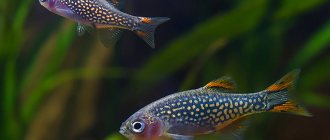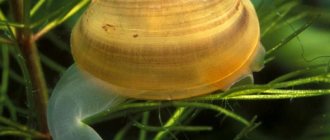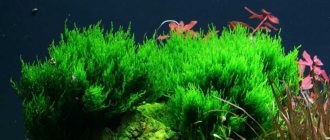Badis Badis or Chameleon Fish (Badis badis) HAMILTON, 1822
The Latin name for the fish, Badis, is probably derived from the Bangla word (Bengali). This species is sometimes sold under the trade name "chameleon fish" due to its ability to change color quickly, especially when cultured or stressed.
Order: Perciformes Family: Badidae
Range and Habitat
Natural habitats in the Ganges River system, from the Yamuna River in Himachal Pradesh, India, to its delta in Bangladesh. It is also found in tributaries of the Ganges in Nepal, while in India it is found in the Mahanadi river system in the states of Chhattisgarh and Orissa, as well as parts of Assam, including the city of Guwahati, Kaziranga National Park and the Dibru river basin.
The terrain type is wide (>100m), shallow (<1m depth), slow-moving stream of water that flows through rice fields and does not have much riparian vegetation. The water was described as "moderately turbid" and "brownish", with a bottom covered in silt in which some (unspecified) aquatic plants grow.
Descriptions of other catching sites also speak in favor of muddy water with a slow current and thickets of underwater vegetation, often associated with a continuous carpet of water lily leaves.
Size
Maximum standard length 50 - 60 mm.
Aquarium
One pair or a small group can be placed in an aquarium with a base measuring 80*30cm or more.
It will feel great in a properly designed aquarium; using sand or gravel as a substrate plus some rounded rocks and cobbles/coarse pebbles to provide cover. Types of aquarium plants that can be grown attached to the decor can also be added if you wish, but this is not a requirement. Natural driftwood and branches, floating plants and dry leaves can also be used to decorate the aquarium, as long as the filtration and lighting should not be too strong.
Some cave-like scenery/grottoes must be included in the underwater landscape to act as potential spawning sites; many breeders use half a coconut shell or upside down ceramic pots with holes for access.
Water parameters
Temperature: 20 – 25° C
pH: 6.0 - 7.5
Hardness: 6 – 18°
Water changes and filtration with aeration are required. It is best to filter the water through peat, then the color of the fish will be even more intense.
Dream Interpretation - Fish underwater creatures
It is a very capacious, multi-valued symbol. Among its meanings, the following meanings may appear in a dream: hidden emotional impulses, in general, various states of consciousness; intuition; activity, sexuality, general state of affairs (“swimming through life”); Vitality, wisdom; coldness, indifference, alienation of a certain person; Religiosity, spirituality (fish traditionally expresses Christianity; Fishermen, disciples of Christ, “catchers of human souls”), luck, familiarization with secret, esoteric knowledge, worries, prosperity, profit, illness, danger (if, for example, you dream of an electric stingray, a shark or sea snake); Fulfillment of desires (goldfish) and, finally, excellent orientation in the surrounding professional environment and business connections (idiom: “swims like a fish in water”). Quite a few night scenes are associated with fish: fishing, fish market... There are many more variations. But the scarcity of these dreamy pictures is easily compensated by the abundance of images of the fish themselves: swimming, dried, dead, exotic, talking, flying, frozen, colored, large, small, huge (whale), fabulous, mythical, golden, aquarium, predatory fish... And each of them is endowed with its own meaning, requiring separate consideration. Moreover, the type of fish itself (carp, pike, salmon, etc.) has its own additional meaning.
Behavior and Compatibility
This species is sedentary and inactive by nature, can be frightened and will not compete in feeding with larger or aggressive fish species. Of course, you should not keep it with territorial bottom-dwelling fish unless the aquarium is very large, and never keep it with other species of Badis, as hybridization may occur. It is worth noting that freshwater shrimp from the popular genera Caridina and Neocaridina can be its prey.
They are a peaceful species, although they are best kept in a species aquarium. These fish are especially useful if you want to reduce the snail population if they are causing a problem in your aquarium. They are shy, tiny, tropical freshwater fish that are considered one of the most underrated species in the aquarium hobby, being neglected despite their spectacular coloring and uniqueness, reminiscent of dwarf cichlids, which makes them a very interesting species to keep and observe.
Peaceful and inactive, they should therefore be kept with similar peaceful, calm fish such as small Rasboras, Characins and Catfishes.
Chameleon fish (Badis badis) are not schooling fish, per se, and rival males can be very aggressive towards each other, especially in confined spaces. In these cases, only one pair or one male and several females will need to be purchased, but in a spacious aquarium other groups can coexist as long as there is room for each male to establish his territory.
Well-planned cave/shelter placement can help in this regard; for example, do not try to group all available spawning areas in one area/location.
Chameleon fish: description
The small freshwater fish received the nickname “chameleon” because of its ability to change color under the influence of external conditions. It can change its color from orange to dark blue and even purple.
Metallic shades are often present in the color. This quality allows the aquatic animal to adapt to the basic color of the natural aquatic environment and objects located in the bottom layer.
- The fish is small in size: from 6 to 8 cm long.
- The body of individuals is oval, flattened on the sides, the line of the body smoothly passes into the head with small black eyes and a small mouth.
- The dorsal fin is dense, long and rather high; it stretches along the entire back, only slightly short of the tail.
- The pectoral fins are small but powerful.
- The fish's tail has a semicircular fan-shaped shape, which helps the “chameleon” move quickly.
The sexual characteristics of individuals of the species are expressed quite clearly.
Females are much paler than males, their fins are transparent, and in males they are colored to match the color of the body. In addition, females are slightly smaller than their partners.
Nutrition
All species of Badis are micropredators, feeding on small aquatic crustaceans, worms, insect larvae and other zooplankton. In the aquarium they often refuse dried food and instead should be offered suitable sized live or frozen food such as Artemia, Daphnia or Koretra.
They are somewhat skittish and cautious eaters, and it is important to note that all species develop problems with obesity and become more susceptible to disease when fed a monotonous diet of bloodworms and tubifex, so they should be excluded from the daily diet.
Badis - sexual dimorphism
Badis sexually mature quite early, depending on the species, at 5-8 months of life. At this age, their length can be 2/3 of the nominal length.
Sexual dimorphism begins to appear even in immature individuals: before feeding, the male can be distinguished by his retracted abdomen, females are more rounded, not so brightly colored, their dorsal and anal fins do not have sharp endings.
A pair of badis in an aquarium
In addition to their bright outfit, larger dimensions and characteristic abdomen shape, males are distinguished by wider and higher anal and dorsal fins, which they are happy to show off to females.
Breeding
Representatives of this genus are shelter/caver spawning fish that form temporary pairs. Other species are best excluded if you want to raise more fry, although in a well-chosen aquarium community some may survive. A pair or group of adults can be placed to spawn, but if multiple males are involved, be sure to provide each of them with a cave.
Water parameters in the spawning tank: dH > 10 °; pH 6.5-7.0; 25-27 °C.
In the wild, seasonal rains are one of the signs that usually signal the start of the breeding season. During the rainy season, the waters of the natural habitat become softer. You can duplicate this effect in your breeding tank through frequent changes (about 15 percent per day for breeding). Demineralized water will also help stimulate their seasonal spawning cycle. A decrease in barometric pressure is another natural trigger for spawning. In fact, many fish species will spawn during or before a storm/thunderstorm.
During and before the spawning period, live food is preferred.
When they are ready to breed, rival males become increasingly aggressive and begin to show interest and courtship with females who happen to be in their territory. During this process, they show changes in coloration, the body begins to darken, becoming almost black with bright blue fins. Gagging is common, with the male literally trying to pull his mate into the cave. The ready female reciprocates, swims inside and spawning occurs, usually 30-100 eggs are laid.
After spawning, the female immediately swims away and the male takes full responsibility for the eggs and larvae, protecting the territory from intruders and fanning the brood with his fins. Any other adult fish may be removed at this point, although this is not absolutely necessary. The larva hatches from the eggs usually after 2-3 days, will swim in another 6-8 days, and after another week or so the juveniles will begin to leave their cave. From this point on, the parent can begin to consider them as food, and it is better to transfer them to a separate aquarium. The fry lead a fairly sedentary lifestyle during the first few days, which means that microfood (ciliates, rotifers) is an ideal initial food, but as soon as they clearly/visibly begin to swim in the water column, Artemia nauplii can be introduced into the diet.
Badis Badis are a rare and colorful aquarium fish that are a great addition even to nano aquariums.
If properly maintained, the Chameleon Fish will live in an aquarium for 3 to 5 years.
Reproduction
Breeding badis at home is problem-free, sometimes you don’t even need a spawning tank. Representatives of the species have a developed parental instinct aimed at protecting the offspring.
For spawning, the pair chooses a secluded corner. The best option is a ceramic pot or a grotto built from stones. The female attaches the eggs to the upper wall of the shelter.
When the breeding season begins, the male acquires a rich body color, becomes more aggressive, and does not allow anyone to the spawning area. He persistently invites the female into the shelter, almost pushing her there.
After laying eggs, the female swims away, and the male protects the future offspring, then protects the fry for a week until they become independent.
Notes
One of the most interesting things about our hobby is having a wide variety of fish. Many of these have been available for generations but have never received more than passing interest from many aquarists, perhaps because these fish tend to be hidden in corners or behind decorations in dealers' aquariums. These fish are often considered incidentals in the aquarium hobby.
This is unfortunate because often these fish can be full of fascinating behaviors, beautiful colors, or interesting breeding habits that even a novice hobbyist will notice. One such often overlooked fish is the Chameleon Fish (Badis badis).
Feeding
In nurseries, they try, of course, to accustom chameleon fish to dry food, but they still prefer live food: worms, daphnia, and coretra. However, dry commercial food can also be included in this diet. Tubifex or bloodworms can also be given, but they must be washed well to avoid stomach diseases.
Yes, if the aquarium contains cherry shrimp and “chameleons” are released into it, then you can say goodbye to shrimp forever. They will be quickly eaten.
